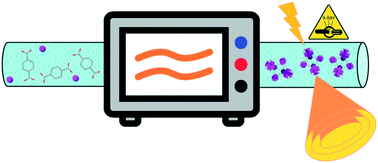In situ high-resolution powder X-ray diffraction study of UiO-66 under synthesis conditions in a continuous-flow microwave reactor†
Abstract
Large scale synthesis of metal–organic frameworks (MOFs) is of high interest, due to their potential for industrial applications. The capacity to synthesize large amounts of MOFs should be combined with the ability to control their properties. Understanding how process parameters influence the formation of the product is necessary to synthesize tailor-made materials. The crystallization process of a MOF from the reaction mixture can be conveniently monitored in real time by performing in situ studies using synchrotron radiation. This yields insight into the formation of the product under the actual reaction conditions. In this work, we performed an in situ high-resolution powder X-ray diffraction study of the crystallization of UiO-66 in a recently developed continuous-flow microwave reactor that provided excellent performances in terms of space-time yield and atom economy. The effect of the addition of different amounts of water and acetic acid to the reaction mixture on the yield and crystallite size of the product was investigated over a range of residence times. UiO-66 was the only crystalline phase observed and two stages of the process were identified, namely, a preliminary stage, where the crystallite size of the MOF increases, and a steady state one where the quality of the product is constant. The yield and crystallite size of the product primarily depended on the water/acetic acid ratio, which was the most important parameter determining the rate of product formation. Increasing the absolute amounts of additives at fixed ratios led to a higher yield of larger crystallites, whereas aging of the metal stock solution led to a higher yield of smaller crystallites. Selected experiments were performed offline isolating the solid at the steady state and characterizing it after workup. In this way, we demonstrated that large scale synthesis of UiO-66 with controlled properties can be performed with a continuous-flow microwave reactor.



 Please wait while we load your content...
Please wait while we load your content...